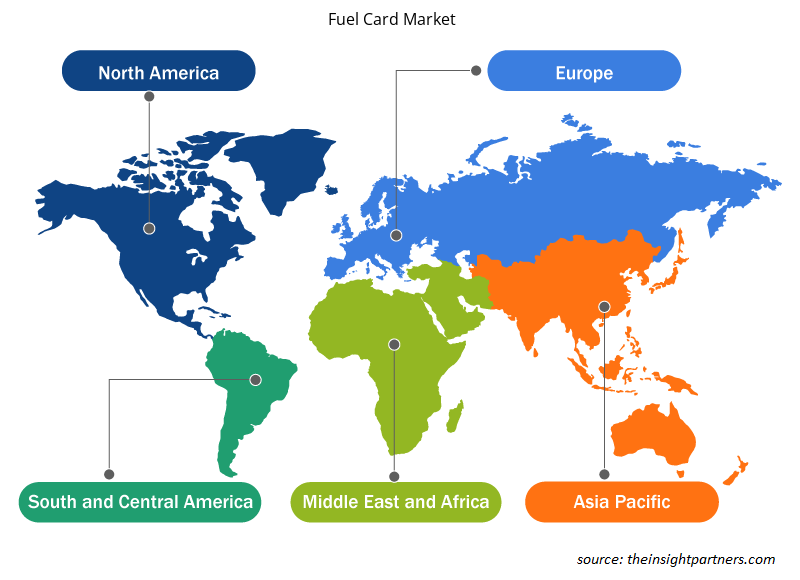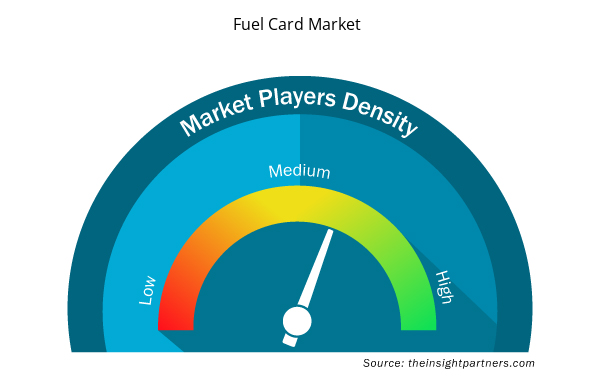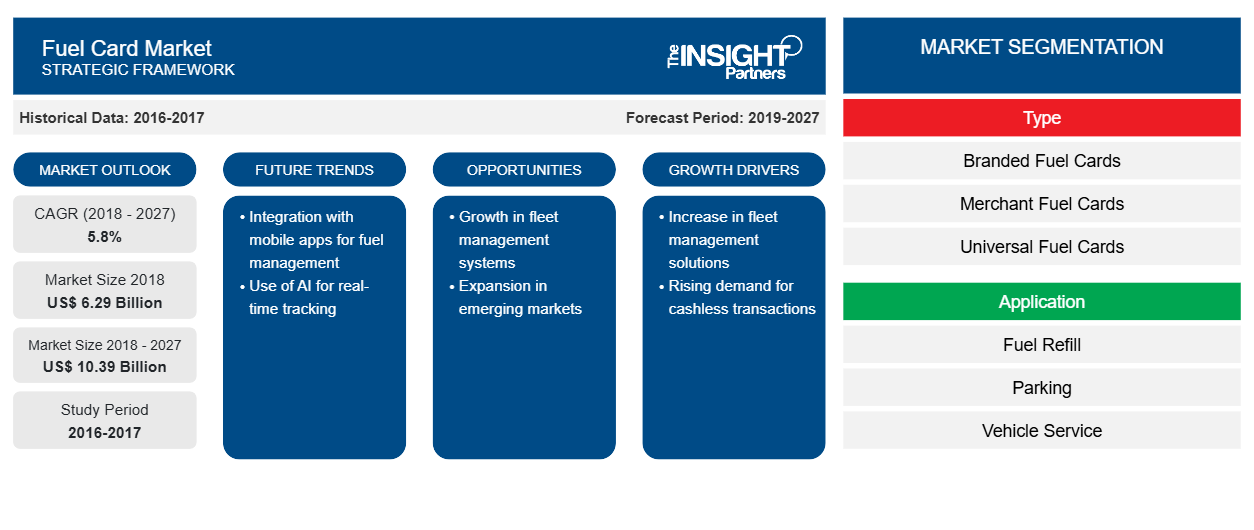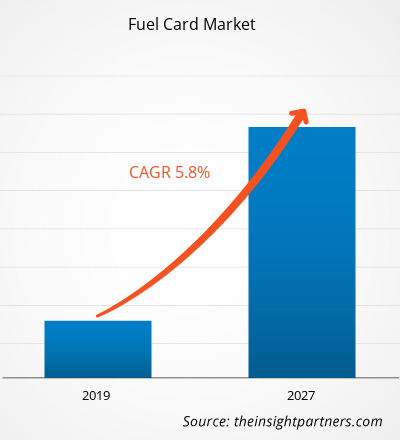[Rapporto di ricerca] Si stima che il mercato globale delle carte carburante abbia raggiunto i 6,29 miliardi di dollari nel 2018 e si prevede che crescerà a un CAGR del 5,8% durante il periodo di previsione 2019-2027, fino a raggiungere i 10,39 miliardi di dollari entro il 2027.
La regione del Nord America detiene una quota di mercato significativa in termini di fatturato generato per le carte carburante e si stima che continuerà a dominare la quota di mercato per tutto il periodo di previsione. Le carte universali sono il tipo di carta carburante più conveniente, i fornitori di queste carte solitamente collaborano con diverse compagnie di carburante e offrono grande flessibilità. Alcune compagnie di carte carburante operano solo in alcuni paesi o regioni, mentre altre potrebbero essere accettate solo in determinate stazioni di servizio. Gli utenti con meno opzioni nella loro regione potrebbero dover essere cauti nel limitarle a poche stazioni di servizio.
Approfondimenti sul mercato delle carte carburante
Gestione efficiente della flotta con l'ausilio di una migliore acquisizione dei dati
Le carte carburante consentono un monitoraggio avanzato delle spese della flotta e dell'efficienza della flotta monitorando in tempo reale il chilometraggio e il consumo di carburante dei veicoli in una flotta. Gli operatori di flotte utilizzano le carte carburante per costi quali manutenzione dei camion, riparazioni dei camion, carburante, pulizia dei camion e noleggio di veicoli sostitutivi, tra gli altri. I dati acquisiti da una carta carburante includono lettura del contachilometri, qualità del carburante, prodotto del carburante e quantità di carburante, ID del veicolo, ID del conducente e informazioni fiscali insieme a dettagli della transazione quali ora, posizione, importo della spesa e data supportano un ricco repowering per i gestori di flotte. Questo fattore alimenterebbe la domanda del mercato delle carte carburante nel periodo di previsione.
Personalizza questo report in base alle tue esigenze
Riceverai la personalizzazione gratuita di qualsiasi report, comprese parti di questo report, o analisi a livello nazionale, pacchetto dati Excel, oltre a usufruire di grandi offerte e sconti per start-up e università
- Scopri le principali tendenze di mercato in questo rapporto.Questo campione GRATUITO includerà analisi di dati che spaziano dalle tendenze di mercato alle stime e alle previsioni.
Minore rischio di frode associato all'utilizzo della carta carburante
L'utilizzo della carta carburante offre vantaggi in termini di funzionalità e sicurezza rispetto a metodi alternativi di pagamento per il carburante come il contante. Le carte possono essere stampate con il numero di targa del veicolo o il nome del conducente e il nome dell'azienda, offrendo ulteriore protezione contro l'utilizzo fraudolento o le carte per il rifornimento. Informazioni complete su tutte le transazioni di carburante riducono la prospettiva di un uso improprio da parte dei dipendenti e offrono un controllo superiore sull'utilizzo autentico del veicolo. Pertanto, si prevede che il mercato delle carte carburante in tutto il mondo crescerà.
Tipo Segmento Insights
Il mercato delle carte carburante per componente è segmentato in carte carburante di marca, carte carburante per commercianti e carte carburante universali. Le carte carburante sono solitamente utilizzate da PMI e grandi aziende per monitorare il consumo di carburante e rendere più comodo il pagamento senza contanti. Tali carte sono più comuni per le aziende o le organizzazioni che si occupano di trasporti e gestione della flotta. Diverse aziende che operano nel settore offrono diversi tipi di carte. Queste carte, oltre al rifornimento di carburante, sono utilizzate per diversi altri scopi. Le carte carburante per emittente possono essere ampiamente indipendenti dalle categorie o di marca.
Approfondimenti sui segmenti applicativi
Il mercato globale delle carte carburante in base all'applicazione è stato segmentato in rifornimento di carburante, parcheggio, assistenza veicoli, addebito pedaggio e altro. Una carta carburante consente agli utenti e ai titolari di attività di gestire e controllare le spese di carburante e manutenzione. Sono generalmente utilizzate come carta di pagamento per i carburanti presso le stazioni di servizio. Inoltre, queste carte possono essere utilizzate anche per il pagamento di altri servizi per veicoli come riparazioni, manutenzione e assistenza stradale. Grazie all'ampia reportistica, diverse carte carburante consentono agli utenti di ottenere report in tempo reale, aiutandoli così a rimanere aggiornati su tutte le spese aziendali e a gestire le tasse sui veicoli.
Approfondimenti regionali sul mercato delle carte carburante
Le tendenze regionali e i fattori che influenzano il mercato delle carte carburante durante il periodo di previsione sono stati ampiamente spiegati dagli analisti di Insight Partners. Questa sezione discute anche i segmenti e la geografia del mercato delle carte carburante in Nord America, Europa, Asia Pacifico, Medio Oriente e Africa, e Sud e Centro America.

- Ottieni i dati specifici regionali per il mercato delle carte carburante
Ambito del rapporto sul mercato delle carte carburante
| Attributo del report | Dettagli |
|---|---|
| Dimensioni del mercato nel 2018 | 6,29 miliardi di dollari USA |
| Dimensioni del mercato entro il 2027 | 10,39 miliardi di dollari USA |
| CAGR globale (2018 - 2027) | 5,8% |
| Dati storici | 2016-2017 |
| Periodo di previsione | 2019-2027 |
| Segmenti coperti | Per tipo
|
| Regioni e Paesi coperti | America del Nord
|
| Leader di mercato e profili aziendali chiave |
|
Densità degli operatori del mercato delle carte carburante: comprendere il suo impatto sulle dinamiche aziendali
Il mercato delle carte carburante sta crescendo rapidamente, spinto dalla crescente domanda degli utenti finali dovuta a fattori quali l'evoluzione delle preferenze dei consumatori, i progressi tecnologici e una maggiore consapevolezza dei vantaggi del prodotto. Con l'aumento della domanda, le aziende stanno ampliando le loro offerte, innovando per soddisfare le esigenze dei consumatori e capitalizzando sulle tendenze emergenti, il che alimenta ulteriormente la crescita del mercato.
La densità degli operatori di mercato si riferisce alla distribuzione di aziende o società che operano in un particolare mercato o settore. Indica quanti concorrenti (operatori di mercato) sono presenti in un dato spazio di mercato in relazione alle sue dimensioni o al valore di mercato totale.
Le principali aziende che operano nel mercato delle carte carburante sono:
- Società a responsabilità limitata
- ExxonMobil Corporation
- Azienda
- Società olandese reale Shell
- Banca degli Stati Uniti
Disclaimer : le aziende elencate sopra non sono classificate secondo un ordine particolare.

- Ottieni una panoramica dei principali attori del mercato delle carte carburante
Alcune delle iniziative di mercato sono state osservate come la strategia più adottata nel mercato globale delle carte carburante. Di seguito sono elencate alcune delle recenti iniziative di mercato:
2019: Edenred Capital Partners investe in aziende innovative con elevato potenziale di crescita in aree correlate alle attività di Edenred. L'obiettivo è quello di migliorare l'ecosistema del Gruppo avviando preziose sinergie con le aziende sostenute.
2018: Edenred, leader mondiale nelle soluzioni transazionali per aziende, dipendenti e commercianti, ha annunciato oggi la firma di un accordo per acquisire l'80% del capitale azionario del gruppo The Right Fuelcard Company (TRFC), il quarto gestore di programmi di carte carburante nel Regno Unito.
SEGMENTAZIONE DEL MERCATO GLOBALE DELLE CARTE CARBURANTE
Mercato globale delle carte carburante – Per tipo
- Carte carburante di marca
- Carte carburante con marchio del commerciante
- Carte carburante universali
Mercato globale delle carte carburante – per applicazione
- Rifornimento di carburante
- Parcheggio
- Servizio di veicoli
- Pedaggio
- Altri
Mercato globale delle carte carburante – Per area geografica
America del Nord
- NOI
- Canada
- Messico
Europa
- Francia
- Germania
- Italia
- Regno Unito
- Spagna
- Resto d'Europa
Asia Pacifico (APAC)
- Cina
- India
- Giappone
- Australia
- Resto dell'APAC
Medio Oriente e Africa (MEA)
- Arabia Saudita
- Emirati Arabi Uniti
- Sudafrica
- Resto del Medio Oriente e Africa
Sud America
- Brasile
- Resto del Sud America
Mercato globale delle carte carburante - Profili aziendali
- Società a responsabilità limitata
- ExxonMobil Corporation
- Azienda
- Società olandese reale Shell
- Banca degli Stati Uniti
- Società a responsabilità limitata Wex Inc.
- DKV
- Servizi di carburante mondiali
- Enerdità
- Soluzioni di pagamento Radius.
Allstar, Arco, Caltex, Chevron Texaco, Commdel, EDC, Engen Petroleum Ltd., FastFuel, Fleetcare Pty Ltd, fuelGenie e Fuelman sono alcuni degli altri attori del mercato della filiera che non sono descritti nel rapporto, ma possono essere inclusi su richiesta.
- Analisi storica (2 anni), anno base, previsione (7 anni) con CAGR
- Analisi PEST e SWOT
- Valore/volume delle dimensioni del mercato - Globale, regionale, nazionale
- Industria e panorama competitivo
- Set di dati Excel



Report Coverage
Revenue forecast, Company Analysis, Industry landscape, Growth factors, and Trends

Segment Covered
This text is related
to segments covered.

Regional Scope
North America, Europe, Asia Pacific, Middle East & Africa, South & Central America

Country Scope
This text is related
to country scope.
Trends and growth analysis reports related to Banking, Financial Services, and Insurance : READ MORE..
The List of Companies
- BP P.L.C.
- Exxon Mobil Corporation
- Fleetcor Technologies, Inc.
- Royal Dutch Shell plc
- U.S. Bank
- Wex Inc.
- DKV
- World Fuel Services
- Edenerd
- Radius Payment Solutions
The Insight Partners performs research in 4 major stages: Data Collection & Secondary Research, Primary Research, Data Analysis and Data Triangulation & Final Review.
- Data Collection and Secondary Research:
As a market research and consulting firm operating from a decade, we have published and advised several client across the globe. First step for any study will start with an assessment of currently available data and insights from existing reports. Further, historical and current market information is collected from Investor Presentations, Annual Reports, SEC Filings, etc., and other information related to company’s performance and market positioning are gathered from Paid Databases (Factiva, Hoovers, and Reuters) and various other publications available in public domain.
Several associations trade associates, technical forums, institutes, societies and organization are accessed to gain technical as well as market related insights through their publications such as research papers, blogs and press releases related to the studies are referred to get cues about the market. Further, white papers, journals, magazines, and other news articles published in last 3 years are scrutinized and analyzed to understand the current market trends.
- Primary Research:
The primarily interview analysis comprise of data obtained from industry participants interview and answers to survey questions gathered by in-house primary team.
For primary research, interviews are conducted with industry experts/CEOs/Marketing Managers/VPs/Subject Matter Experts from both demand and supply side to get a 360-degree view of the market. The primary team conducts several interviews based on the complexity of the markets to understand the various market trends and dynamics which makes research more credible and precise.
A typical research interview fulfils the following functions:
- Provides first-hand information on the market size, market trends, growth trends, competitive landscape, and outlook
- Validates and strengthens in-house secondary research findings
- Develops the analysis team’s expertise and market understanding
Primary research involves email interactions and telephone interviews for each market, category, segment, and sub-segment across geographies. The participants who typically take part in such a process include, but are not limited to:
- Industry participants: VPs, business development managers, market intelligence managers and national sales managers
- Outside experts: Valuation experts, research analysts and key opinion leaders specializing in the electronics and semiconductor industry.
Below is the breakup of our primary respondents by company, designation, and region:

Once we receive the confirmation from primary research sources or primary respondents, we finalize the base year market estimation and forecast the data as per the macroeconomic and microeconomic factors assessed during data collection.
- Data Analysis:
Once data is validated through both secondary as well as primary respondents, we finalize the market estimations by hypothesis formulation and factor analysis at regional and country level.
- Macro-Economic Factor Analysis:
We analyse macroeconomic indicators such the gross domestic product (GDP), increase in the demand for goods and services across industries, technological advancement, regional economic growth, governmental policies, the influence of COVID-19, PEST analysis, and other aspects. This analysis aids in setting benchmarks for various nations/regions and approximating market splits. Additionally, the general trend of the aforementioned components aid in determining the market's development possibilities.
- Country Level Data:
Various factors that are especially aligned to the country are taken into account to determine the market size for a certain area and country, including the presence of vendors, such as headquarters and offices, the country's GDP, demand patterns, and industry growth. To comprehend the market dynamics for the nation, a number of growth variables, inhibitors, application areas, and current market trends are researched. The aforementioned elements aid in determining the country's overall market's growth potential.
- Company Profile:
The “Table of Contents” is formulated by listing and analyzing more than 25 - 30 companies operating in the market ecosystem across geographies. However, we profile only 10 companies as a standard practice in our syndicate reports. These 10 companies comprise leading, emerging, and regional players. Nonetheless, our analysis is not restricted to the 10 listed companies, we also analyze other companies present in the market to develop a holistic view and understand the prevailing trends. The “Company Profiles” section in the report covers key facts, business description, products & services, financial information, SWOT analysis, and key developments. The financial information presented is extracted from the annual reports and official documents of the publicly listed companies. Upon collecting the information for the sections of respective companies, we verify them via various primary sources and then compile the data in respective company profiles. The company level information helps us in deriving the base number as well as in forecasting the market size.
- Developing Base Number:
Aggregation of sales statistics (2020-2022) and macro-economic factor, and other secondary and primary research insights are utilized to arrive at base number and related market shares for 2022. The data gaps are identified in this step and relevant market data is analyzed, collected from paid primary interviews or databases. On finalizing the base year market size, forecasts are developed on the basis of macro-economic, industry and market growth factors and company level analysis.
- Data Triangulation and Final Review:
The market findings and base year market size calculations are validated from supply as well as demand side. Demand side validations are based on macro-economic factor analysis and benchmarks for respective regions and countries. In case of supply side validations, revenues of major companies are estimated (in case not available) based on industry benchmark, approximate number of employees, product portfolio, and primary interviews revenues are gathered. Further revenue from target product/service segment is assessed to avoid overshooting of market statistics. In case of heavy deviations between supply and demand side values, all thes steps are repeated to achieve synchronization.
We follow an iterative model, wherein we share our research findings with Subject Matter Experts (SME’s) and Key Opinion Leaders (KOLs) until consensus view of the market is not formulated – this model negates any drastic deviation in the opinions of experts. Only validated and universally acceptable research findings are quoted in our reports.
We have important check points that we use to validate our research findings – which we call – data triangulation, where we validate the information, we generate from secondary sources with primary interviews and then we re-validate with our internal data bases and Subject matter experts. This comprehensive model enables us to deliver high quality, reliable data in shortest possible time.


 Ottieni un campione gratuito per questo repot
Ottieni un campione gratuito per questo repot